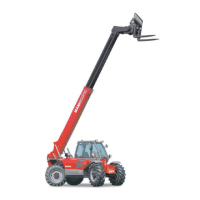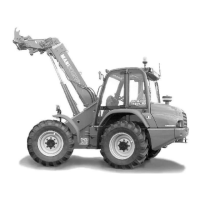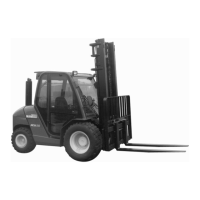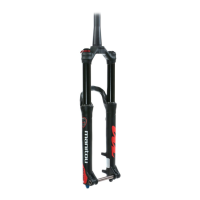1-14
1-14
INSTRUCTIONS FOR HANDLING A LOADINSTRUCTIONS FOR HANDLING A LOAD
A - CHOICE OF ATTACHMENTSA - CHOICE OF ATTACHMENTS
-- Only attachments approved by MANITOU Only attachments approved by MANITOU can be used on its lift tcan be used on its lift trucks.rucks.
-- Make sure the attachment is appropriate for the work to be done (see: 4 Make sure the attachment is appropriate for the work to be done (see: 4 - ADAPTABLE A- ADAPTABLE ATTACHMENTS IN OPTION ON THE RANGE).TTACHMENTS IN OPTION ON THE RANGE).
-- If the lift truck is equipped with the Single side-shift carriage OPTIOIf the lift truck is equipped with the Single side-shift carriage OPTION (TSDL), use only the authorised attachments (see: N (TSDL), use only the authorised attachments (see: 4 - ADAPTABLE4 - ADAPTABLE
ATTATTACHMENTS IN OPTION ACHMENTS IN OPTION ON THE RANGE).ON THE RANGE).
- Make sure the attachment is correctly installed and locked onto the lift truck carriage.- Make sure the attachment is correctly installed and locked onto the lift truck carriage.
- Make sure that your l- Make sure that your lift truck attachments work properly.ift truck attachments work properly.
- Comply with the load chart limits for the lift truck for the attachment used.- Comply with the load chart limits for the lift truck for the attachment used.
- Do not exceed the rated - Do not exceed the rated capacity of the attachment.capacity of the attachment.
-- Never lift a load in a sling without the attachment provided for the purpose, as the sling risks to slip (see: INSTRUCTIONS FORNever lift a load in a sling without the attachment provided for the purpose, as the sling risks to slip (see: INSTRUCTIONS FOR
HANDLING A LOAD: H HANDLING A LOAD: H - TAKING UP AND LAYING DOWN A SUSPENDED LOAD).- TAKING UP AND LAYING DOWN A SUSPENDED LOAD).
B - MASS OF LOAD AND CENTRE OF GRAVITYB - MASS OF LOAD AND CENTRE OF GRAVITY
- Before taking up a - Before taking up a load, you must know its mass and iload, you must know its mass and its centre of gravity.ts centre of gravity.
-- The load chart for your lift truck is valid for a load in which the longitudinal position of The load chart for your lift truck is valid for a load in which the longitudinal position of thethe
centre of gravity is 500 mm from the base of the forks (fig. B1). For a higher centre ofcentre of gravity is 500 mm from the base of the forks (fig. B1). For a higher centre of
gravity, contact your gravity, contact your dealer.dealer.
-- For irregular loads, determine the transverse centre of gravity For irregular loads, determine the transverse centre of gravity before any movement (fig.before any movement (fig.
B2) and set it in the longitudinal axis of the lift truck.B2) and set it in the longitudinal axis of the lift truck.
It is forbidden to move a It is forbidden to move a load heavier than the effective capacity defined on the load heavier than the effective capacity defined on the lift truck load chart.lift truck load chart.
For loads with a moving centre of gravity (e.g. liquids), take account of the variations in the centre ofFor loads with a moving centre of gravity (e.g. liquids), take account of the variations in the centre of
gravity in order to gravity in order to determine the load to be handled and be determine the load to be handled and be vigilant and take extra care to vigilant and take extra care to limit theselimit these
variations as far as possible.variations as far as possible.
C - LONGITUDINAL STABILITY ALARMC - LONGITUDINAL STABILITY ALARM
-- This device gives an indication of This device gives an indication of the lift truck’s longitudinal stabilitythe lift truck’s longitudinal stability. Move the jib very. Move the jib very
carefully when approaching the authorized lcarefully when approaching the authorized load limit (see: 2 - oad limit (see: 2 - DESCRIPTION: INSTRUMENTSDESCRIPTION: INSTRUMENTS
AND CONTROLS).AND CONTROLS).
- Always watch this device during - Always watch this device during handling operations.handling operations.
-- When the device is in alert mode, it is forbidden to When the device is in alert mode, it is forbidden to perperform so-called «AGGRAform so-called «AGGRAVAVATING»TING»
movements, these being:movements, these being:
A - Extending the jib.A - Extending the jib.
B - Lowering the jib.B - Lowering the jib.
-- PerPer form movements to relieve aggravation form movements to relieve aggravation in the following order (fig. in the following order (fig. C): if necessC): if necessarary,y,
raise the jib (1), retract the jib as far as possible (2) and lower the jib (3) to release theraise the jib (1), retract the jib as far as possible (2) and lower the jib (3) to release the
load.load.
The instrument reading may be erroneous when the steering is at its maximum limit or the rear axleThe instrument reading may be erroneous when the steering is at its maximum limit or the rear axle
oscillated to its limit. Before lifting a load, make sure that the lift truck is not in either of theseoscillated to its limit. Before lifting a load, make sure that the lift truck is not in either of these
situations.situations.
500 mm500 mm
B1B1
B2B2
11
22
33
CC

